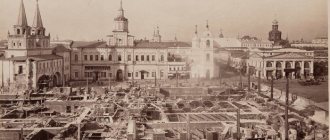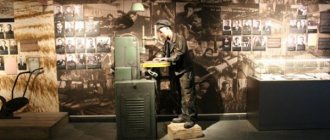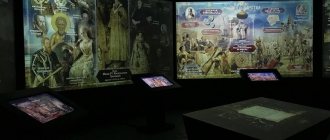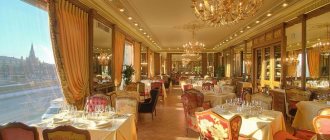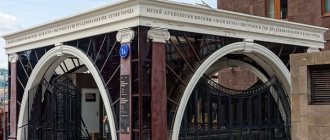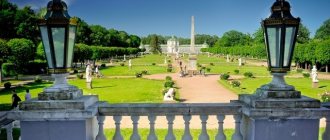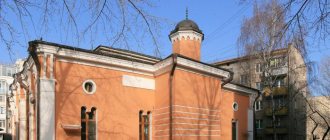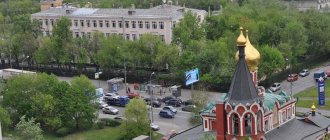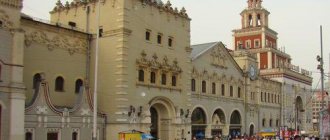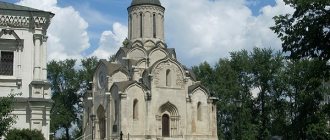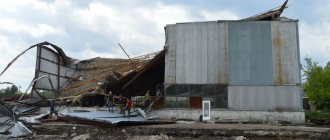Each hall of the State Historical Museum is a small architectural masterpiece and historical exhibit. We study together with Sofia Bagdasarova.
The State Historical Museum was built when impersonal museum halls with white walls had not yet become fashionable. Each of the halls was conceived as an architectural frame for the exhibition and had its own theme. Temples and other buildings of the corresponding era were cited in the interior decoration. And the projects were developed by the best architects of that time. Here are a few of these exhibit halls.
Front entrance
What time: XV-XIX centuries What inspired: Novospassky Monastery (Moscow), St. Sophia Cathedral (Novgorod), St. Basil's Cathedral, Assumption Cathedral of the Moscow Kremlin, the Chamber of Facets, the Church of St. Nicholas the Martyr beyond the Yauza, Vasilyevsky Monastery near Kideksha.
Front entrance. Photo: State Historical Museum press service
Front entrance. Photo: State Historical Museum press service
Front entrance. Photo: State Historical Museum press service
The huge Front Entrance was once the main entrance to the museum. The most memorable thing about the decor of the entryway is the ceiling. This is a giant painting depicting the symbolic family tree of Russian rulers - from Equal-to-the-Apostles Princes Olga and Vladimir to Emperor Alexander III and his wife (68 portraits in total). The tree was created based on the 17th century fresco “Tree of the Russian Sovereigns” in the Cathedral of the Novospassky Monastery in Moscow - the ancestral tomb of the Romanov boyars. That painting, created under Princess Sophia, was badly damaged (after all, after the revolution there was a penal colony in the monastery). Some of the frescoes were removed from the walls and are now stored in the State Historical Museum. This painting was whitewashed in the 20th century.
The ornament that covers the walls repeats the “herbs” that were used to decorate the royal seat of Ivan the Terrible in Novgorod Sofia. And the basement part of the “artificial marble” walls is modeled after the porches of St. Basil’s Cathedral. The lions at the pylons of the marble staircase were taken from the Red Porch of the Faceted Chamber in the Kremlin. The gilded lattice at the entrance to the Byzantine hall repeats the pattern of the carved canopy from the Kremlin Assumption Cathedral - and on the reverse side the portal is modeled after the Church of Nikita the Martyr behind the Yauza and the Vasilievsky Monastery near Kideksha.
Exhibitions
The treasures collected in the museum are exhibited in 39 rooms. However, on an area of 4000 sq. m managed to place only 22 thousand exhibits. This is only a small part of the items stored in the historical museum - 0.5% of the available funds. All exhibits of the State Historical Museum cannot be viewed during one visit. If you linger at each display case for just one minute, it would take 360 hours to fully explore the collection! It is not surprising that such a huge museum employs more than 800 employees.
The Historical Museum is considered the largest national museum in the country, and is visited by up to 1.2 million people annually. In order for tourists to be able to see rare artifacts stored in storerooms, exhibitions are organized here all year round.
Walking through the halls of the museum, visitors can learn about the history of the country, from ancient times to the beginning of the last century. Recently, you can view the main exhibitions virtually. To do this, just go to the museum’s website.
Byzantine hall
What time: III-XII centuries What was inspired by: catacombs of Rome, mausoleum of Galla Placidia (Ravenna), Tatev Monastery (Armenia), Hagia Sophia (Istanbul), Pantocrator Monastery (Istanbul), Monreale Cathedral (Palermo) Important exhibit: carved cup by Emperor Peter I with his own hand from walnut in 1709
Byzantine hall. Photo: State Historical Museum press service
Byzantine hall. Photo: State Historical Museum press service
Byzantine hall. Photo: State Historical Museum press service
The three halls of the Christian Enfilade (now the “Gold” exhibition is located here) illustrated Byzantine art, to which Russian art owed so much. To decorate it, the architects studied those early Christian monuments that are still very difficult to see today - the catacombs of Rome, as well as Byzantine mosaics of Ravenna, Istanbul and Sicilian temples.
The first hall is a smaller copy of the central space of Hagia Sophia in Constantinople. A mosaic depicting Emperor Leo VI at the feet of Christ was copied from there. The enfilade is also decorated with copies of frescoes from the Roman catacombs of Saints Callistus, Priscilla, Agnes, Cornelius, Praetextatus and Lucina. The composition “The Good Shepherd” was taken from the Ravenna mausoleum of Galla Placidia, and the floor, where a dove with an olive branch is depicted, is a copy of the mosaic covering from the catacombs of St. Helena in Rome, excavated in 1838.
Hall No. 2 (Stone Age hall)
What time: the primitive era What inspired: archaeological monuments of the village of Volosovo on the Oka River Important exhibit: figurine of an Arctic partridge from the Malta site in the Irkutsk region, made 22-20 thousand years ago, bone carving
Hall No. 2. Photo: State Historical Museum press service
Hall No. 2. Photo: State Historical Museum press service
Hall No. 2. Photo: State Historical Museum press service
This room is dedicated to the Neolithic era and is decorated with patterns borrowed from the pit-comb decoration of vessels found in the mid-19th century near the village of Volosovo.
But the key to the decoration of the hall is the “Stone Age” panel, created by artist Viktor Vasnetsov. To paint it, philanthropist Savva Mamontov built a workshop for Vasnetsov in his Abramtsevo estate, and local peasants and guests of the Mamontovs (including Valentin Serov) posed for the artist.
The plot, unusual for a storyteller, is interpreted quite naturalistically: people are unwashed, shaggy... There are several scenes: “Making fire and catching fish,” “Processing hides,” “Mammoth hunting,” “Feast.” Vasnetsov drew on the basis of the data provided to him by scientists of the late 19th century (his consultants were Moscow University anthropologist Dmitry Anuchin and archaeologist Vladimir Sizov), and today many elements of his “reconstruction” are considered outdated and erroneous.
The building of the Historical Museum in Moscow
In the 15th-16th centuries there was a postal yard here, then the Sytny Ottotochny yard, and then the Zemsky Prikaz, the central authority. In 1699, a separate building was erected for him - a beautiful two-story mansion in the Naryshkin Baroque style, sporting a turret and platbands. Part of its premises was subsequently given to the Main Pharmacy. From 1755 to 1793, Moscow University was located here, and after that - the offices of the city authorities. In 1874, this territory was allocated for the construction of the Historical Museum building.
According to the original plans, the old Zemsky Prikaz was to be preserved in the courtyard of the new complex, but in 1875 the house was demolished. The building of the State Historical Museum, built according to the architectural design of A. A. Semenov and V. O. Sherwood, is made in the pseudo-Russian style in the appearance and likeness of a tower - it reflects the historical past of great Russia. The two main towers are crowned with double-headed imperial eagles, the smaller side tents are decorated with lions and unicorns, and the facades amaze with the abundance of skillful small decor - kokoshniks, flies, arches, weights, icon cases, drawn cornices and platbands. Unfortunately, the full implementation of the project was never carried out: cladding the huge structure turned out to be too expensive. Pseudo-Russian motifs are also present inside the building, but each of the numerous halls has its own “highlights”. The most famous of the masters were involved in their design - V. M. Vasnetsov, I. K. Aivazovsky, G. I. Semiradsky.
In 1889, the museum building was expanded with a transverse building, installed between the small and large courtyards and designed for 500 seats. In 1914, an archive, library and manuscript department were created on the site of the dismantled lecture hall. The project was led by I. E. Bondarenko.
The building of the State Historical Museum is protected by UNESCO as an integral part of the ensemble of Red Square.
© Tatyana Lisker
Hall No. 5 (Iron Age hall)
What time: Iron Age Inspiration: jewelry and ceramics of the “animal style” Important exhibit: ceremonial axes of the 4th–5th centuries BC. e., found in the Arkhangelsk province on the banks of the Pinega River
Hall No. 5. Photo: State Historical Museum press service
Hall No. 5. Photo: State Historical Museum press service
Hall No. 5. Photo: State Historical Museum press service
The room, dedicated to the Iron Age, is decorated with decorative motifs in the “animal style”. The most famous examples of this art are Scythian gold jewelry, but the Sarmatians and other peoples of Europe and Asia also worked in it.
The heads of animals and birds on the cornice are taken from finds in the Meryan and Yekaterinoslav burial mounds, and the relief above the doorway with a fantastic bird is inspired by Siberian gold jewelry from the Hermitage. The lions in the hall are copied from objects in Scythian graves, and the floor mosaic repeats pottery patterns from the burial mounds of the Vladimir and Yaroslavl provinces.
Novgorod Hall (No. 9)
What time: XII-XV centuries What inspired: Church of the Savior on Nereditsa, Church of St. George on Staraya Ladoga, icons “Battle of Novgorodians with Suzdalians”, “The Sign” Important exhibit: birch bark document from the 1220s–30s with a “self-portrait” of a Novgorod boy Onfima (from a set of his exercises)
Novgorod Hall. Photo: press service of the State Historical Museum
Novgorod Hall. Photo: press service of the State Historical Museum
Novgorod Hall. Photo: press service of the State Historical Museum
To decorate this hall, an artel of Palekh craftsmen was invited, led by restoration artist Nikolai Sofonov, who made copies of the frescoes of the Savior on Nereditsa (later destroyed by the Nazis). In the center of the vault, as if in the dome of a temple, the Ascension of Christ is depicted. On the walls are saints and a composition depicting Prince Yaroslav presenting a model of this church to Christ. One of the paintings repeats the famous icon “Battle of the Novgorodians with the Suzdalians”, the other is the plan of Ancient Novgorod from the icon “The Sign” from the Church of the Archangel Michael. For ideological reasons, this and other halls with “Christian” frescoes were whitewashed during Soviet times and only opened after restoration in the 1990s–2000s.
To decorate the hall, a copy of the Korsun Gate of Novgorod Sofia was made. The mosaic floor is inspired by the ornaments from the Church of St. George on Staraya Ladoga, and the arched openings are decorated after the portals of Sophia of Novgorod.
Opening hours
The museum's opening hours vary depending on the season.
During the period from September 1 to May 31, the complex is open from 10.00 to 18.00 on all days except Friday and Saturday. These days it is open from 10.00 to 21.00. Day off is Tuesday.
November 22 and 28 — the museum is closed.
November 26, as well as December 3, 10 and 24 - from 10:00 to 18:00.
During the summer period from June 1 to August 31, the museum is open daily from 10.00 to 21.00.
The box office hours end 1 hour before the State Historical Museum closes.
Vladimirsky Hall (No. 10)
What time: XII-XV centuries What inspired: Dmitrievsky Cathedral (Vladimir), Assumption Cathedral (Vladimir) Important exhibit: Polovtsian “woman” from the village of Stupki, Donetsk region - a pagan idol of the 13th century
Vladimirsky Hall. Photo: press service of the State Historical Museum
Vladimirsky Hall. Photo: press service of the State Historical Museum
Vladimirsky Hall. Photo: press service of the State Historical Museum
The decor of this room is “white stone”: casts of reliefs from St. Demetrius Cathedral are used here. These are compositions depicting King David and Alexander the Great, a family portrait of Vsevolod the Big Nest with his sons. The interior is complemented by frescoes from the Assumption Cathedral, which were created by the same Palekh artel. Moreover, at the time when the work was going on, the frescoes in the Assumption Cathedral had just been uncovered, and it was Sofonov who made their tracings. The mosaic floor drawing was taken from the same place.
